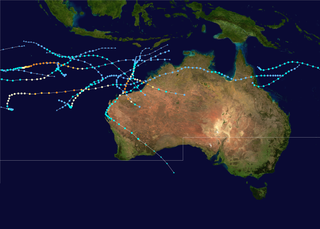
The 1999–2000 Australian region cyclone season was a slightly above average tropical cyclone season. It ran from 1 November 1999 to 30 April 2000. The regional tropical cyclone operational plan also defines a "tropical cyclone year" separately from a "tropical cyclone season", with the "tropical cyclone year" for this season lasting from 1 July 1999 to 30 June 2000.

The 2008–09 Australian region cyclone season was a near average tropical cyclone season. It officially started on 1 November 2008, and officially ended on 30 April 2009. This season was also the first time that the BoM implemented a "tropical cyclone year." The regional tropical cyclone operational plan defines a "tropical cyclone year" separately from a "tropical cyclone season"; the "tropical cyclone year" began on 1 July 2008 and ended on 30 June 2009.

The 2010–11 Australian region cyclone season was a near average tropical cyclone season, with eleven tropical cyclones forming compared to an average of 12. The season was also the costliest recorded in the Australian region basin, with a total of $3.62 billion in damages, mostly from the destructive Cyclone Yasi. The season began on 1 November 2010 and ended on 30 April 2011, although the first tropical cyclone formed on 28 October. The Australian region is defined as being to the south of the equator, between the 90th meridian east and 160th meridian east. Tropical cyclones in this area are monitored by five Tropical Cyclone Warning Centres (TCWC's): Jakarta, Port Moresby, Perth, Darwin, and Brisbane, each of which have the power to name a tropical cyclone. The TCWC's in Perth, Darwin, and Brisbane are run by the Bureau of Meteorology, who designate significant tropical lows with a number and the U suffix. The Joint Typhoon Warning Center also issues unofficial warnings for the region, designating significant tropical cyclones with the "S" suffix when they form west of 135°E, and the "P" suffix when they form east of 135°E.

The 2003–04 South Pacific cyclone season was a below-average season with only three tropical cyclones occurring within the South Pacific to the east of 160°E. The season officially ran from November 1, 2003 to April 30, 2004 with the first disturbance of the season forming on December 4 and the last disturbance dissipating on April 23. This is the period of the year when most tropical cyclones form within the South Pacific Ocean.
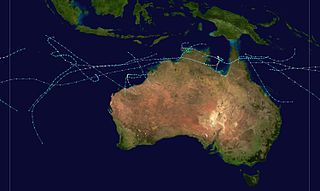
The 1984–85 Australian region cyclone season was one of the most active seasons on record. It officially started on 1 November 1984, and officially ended on 30 April 1985.

Tropical Cyclone Kate was a short-lived Category 2 cyclone that remained nearly stationary for its entire existence in the northwestern Coral Sea in February 2006. Forming out of a monsoonal trough on 22 February, Kate rapidly intensified throughout the day. By 23 February, the system attained its peak intensity with winds of 95 km/h and a barometric pressure of 985 hPa (mbar). Shortly thereafter, increasing wind shear caused the storm to quickly weaken. By 24 February, the system dissipated over open waters near Queensland, Australia. Although Kate did not directly affect land, large swells produced by the storm impacted beaches in Papua New Guinea and Queensland. The waves injured six people in Australia, although no property damage was reported.
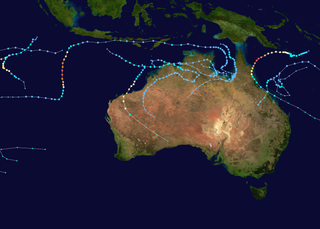
The 2013–14 Australian region cyclone season was a slightly below-average tropical cyclone season, with 10 tropical cyclones occurring within the Australian region. It officially started on 1 November 2013, and ended on 30 April 2014. The regional tropical cyclone operational plan defines a "tropical cyclone year" separately from a "tropical cyclone season"; the "tropical cyclone year" began on 1 July 2013 and ended on 30 June 2014.

The 2014–15 Australian region cyclone season was a slightly below average tropical cyclone season, though it featured numerous intense cyclones. The season officially ran from 1 November 2014, to 30 April 2015, however, a tropical cyclone could form at any time between 1 July 2014, and 30 June 2015, and would count towards the season total. During the season, tropical cyclones were officially monitored, by one of the five Tropical Cyclone Warning Centres (TCWCs) that are operated in this region.

The 2016–17 Australian region cyclone season, despite a very high number of tropical lows, was a slightly below-average season in terms of activity, with nine tropical cyclones, three of which intensified further into severe tropical cyclones; though it was much more active than the previous season. The season was the first to have a severe tropical cyclone since the 2014–15 season. It was the period of the year when most tropical cyclones form in the Southern Indian Ocean and Pacific Oceans between 90°E and 160°E. The season officially ran from 1 November 2016 to 30 April 2017, however, a tropical cyclone could form at any time between 1 July 2016 and 30 June 2017 and would count towards the season total. The first named storm, Yvette, developed during 21 December, and the final named storm, Greg, left the region on 3 May as a remnant low. This season was also the second-costliest tropical cyclone season on record in the Australian region basin, behind only the 2010–11 season, with a total of AUD$3.7 billion in damages incurred by the various storms, mostly from Cyclone Debbie.

The 2017–18 Australian region cyclone season was an average period of tropical cyclone formation in the Southern Indian Ocean and South Pacific Ocean, between 90°E and 160°E, with 11 named storms, which 3 intensified into severe tropical cyclones. Another two tropical cyclones, Cempaka and Flamboyan occurred outside the Australian region but are included in the descriptions below. The season officially began 1 November 2017 and ended on 30 April 2018; however, tropical cyclones can form at any time of the year, as demonstrated by the first tropical low of the season in early August. Any tropical system that forms between 1 July 2017 and 30 June 2018 will count towards the season total. During the season, tropical cyclones will be officially monitored by one of the five tropical cyclone warning centres (TCWCs) that operate in this region. Three of the five centres are operated by the Australian Bureau of Meteorology (BOM) in Perth, Darwin and Brisbane, while the other two are operated by the National Weather Service of Papua New Guinea in Port Moresby and the Indonesian Agency for Meteorology, Climatology and Geophysics in Jakarta. The Joint Typhoon Warning Center (JTWC) of the United States and other national meteorological services, including Météo-France at Réunion, also monitored the basin during the season.

The 2018–19 Australian region cyclone season was an average season that saw the formation of 11 tropical cyclones, six of which intensified further to become severe tropical cyclones. The season officially began on 1 November 2018 and concluded on 30 April 2019; however, as evidenced by Tropical Low Liua in September 2018 and Tropical Cyclones Lili and Ann in May 2019, tropical cyclones can form at any time of the year. As such, any system existing between 1 July 2018 and 30 June 2019 would count towards the season total. During the season, tropical cyclones were officially monitored by the Bureau of Meteorology (BOM), the Indonesian Agency for Meteorology, Climatology and Geophysics (BMKG) in Jakarta, Indonesia, and the National Weather Service of Papua New Guinea in Port Moresby. The United States' Joint Typhoon Warning Center (JTWC) in Hawaii, and other national meteorological services such as MetService in New Zealand, Météo-France at La Réunion, and the Fiji Meteorological Service (FMS), also monitored parts of the basin during the season in an unofficial capacity.

Severe Tropical Cyclone Gillian was the second most powerful of the 2013–14 Australian region cyclone season and the strongest in the basin in four years. It developed on 8 March, 2014, in the Gulf of Carpentaria offshore northern Australia. It drifted southeastward, moving over northwestern Queensland on 10 March as a weak tropical cyclone, and subsequently turned to the southwest and later to the west. Unfavourable wind shear, land interaction, and dry air prevented much restrengthening, and for several days Gillian was a weak tropical low. The storm moved northward and curved westward around the Top End of northwestern Australia, and subsequently moved across several islands in Indonesia, first Timor on 18 March. On 21 March, Gillian again became a tropical cyclone as it moved away from Indonesia. On the next day, it passed just southeast of Christmas Island as an intensifying storm, and subsequently Gillian underwent rapid deepening. On 23 March, the Bureau of Meteorology (BoM) estimated peak 10-minute sustained winds of 220 km/h (140 mph). On the same day, the Joint Typhoon Warning Center (JTWC) estimated peak 1-minute sustained winds of 260 km/h (160 mph), making it a Category 5 on the Saffir–Simpson hurricane wind scale. Increased wind shear caused the cyclone to rapidly weaken, and both BoM and JTWC discontinued advisories on Gillian on 26 March.

Severe Tropical Cyclone Lam was the strongest storm to strike Australia's Northern Territory since Cyclone Monica in 2006. It formed from the monsoon trough on February 12 in the Coral Sea. For much of its duration, the system moved westward due to a ridge to the south. The system crossed over the Cape York Peninsula and moved into the Gulf of Carpentaria, whereupon it gradually organized due to warm waters and favorable outflow. On February 16, the Bureau of Meteorology (BoM) classified it as a Category 1 on the Australian tropical cyclone intensity scale and gave it the name Lam. The storm intensified further while drifting toward the Wessel Islands, developing an eye and strengthening to the equivalence of a minimal hurricane on February 18. It strengthened to reach maximum sustained winds of 185 km/h (115 mph) early on February 19 before turning to the southwest, making it a Category 4 cyclone. That day, it made landfall on Northern Territory between Milingimbi and Elcho Island at peak intensity, and it rapidly weakened over land. About six hours after Lam moved ashore, Cyclone Marcia struck Queensland as a Category 5 cyclone, marking the first time on record that two storms of Category 4 intensity struck Australia on the same day.
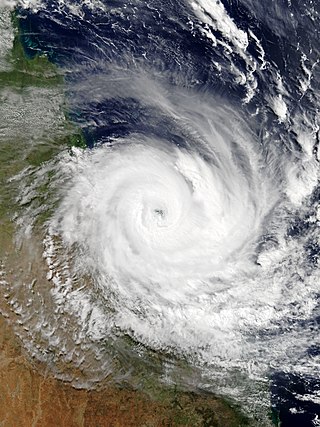
Severe Tropical Cyclone Debbie in 2017 was the strongest tropical cyclone to strike Queensland since Marcia in 2015, and was the costliest tropical cyclone in Australia since Yasi in 2011. Forming as a tropical low on 23 March, the low gradually intensified into a named tropical cyclone on 25 March. After steadily strengthening offshore to a Category 4 system, Debbie eventually made landfall near Airlie Beach, at 12:40 AEST on 28 March. Afterwards, Debbie rapidly weakened into a tropical low by late 28 March, but continued to travel south, causing significant damage and flooding in the populous areas of South East Queensland and Northern Rivers. In total, the storm caused A$3.5 billion (US$2.67 billion) in damage and fourteen deaths across Australia, primarily as a result of extreme flooding. This makes Debbie the deadliest cyclone to hit Australia since Fifi in 1991.
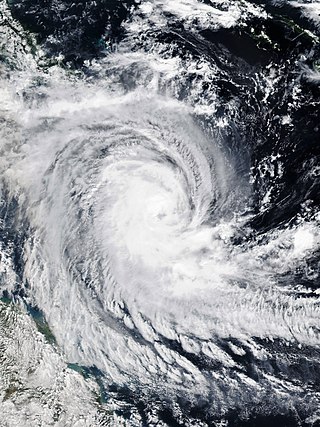
Tropical Cyclone Ann was a small off-season tropical cyclone that brought minor impacts to the Solomon Islands, Far North Queensland and coastal regions of the Northern Territory's Top End during May 2019. Ann was the twenty-fifth tropical low, eleventh tropical cyclone, ninth Category 2 tropical cyclone and second off-season tropical cyclone of the 2018–19 Australian region cyclone season. The system developed from a tropical low that formed on 7 May in the South Pacific cyclone region. The low gradually intensified while moving southwards, and strengthened into a tropical cyclone on 11 May. The storm then turned to the west-northwest and continued to strengthen over the Coral Sea. Ann reached peak intensity on 12 May as a Category 2 tropical cyclone on the Australian scale, with 10-minute sustained winds of 100 km/h (65 mph) and a central barometric pressure of 990 hPa (29.23 inHg). One-minute sustained winds of 110 km/h (70 mph) made Ann equivalent to a strong tropical storm on the Saffir–Simpson hurricane wind scale. The storm began to decay soon afterwards, and weakened to a gale-force tropical low on 14 May. Ann made landfall near Lockhart River on Cape York Peninsula on 15 May, before re-emerging over water a few hours later. Ann maintained a steady west-northwestwards track for several days before dissipating as a tropical low near East Timor on 18 May.

Severe Tropical Cyclone Owen was an erratic and long-lived tropical cyclone that affected numerous regions within its long trek, especially Queensland, during December 2018. It was the fourth tropical low, the first tropical cyclone, and first severe tropical cyclone of the 2018–19 Australian region cyclone season. Owen developed on 29 November 2018 from an area of low pressure that was situated over the Solomon Islands; the system struggled to strengthen in a conflicting environment and degenerated to a tropical low on 3 December. The low drifted westward, and on 9 December, it made its first landfall in Queensland, before moving over the Gulf of Carpentaria, where more favourable conditions allowed it to re-organise. The system regenerated into a tropical cyclone on 12 December and rapidly intensified into a Category 3 severe tropical cyclone that night. At midnight on 13 December, Owen made landfall in the Northern Territory, before turning eastward and reaching peak intensity, with sustained winds of 150 km/h (95 mph) and a minimum barometric pressure of 958 hPa (28.3 inHg). On 13 December, Owen made landfall on Queensland again, just north of the mouth of the Gilbert River near Kowanyama. The cyclone weakened rapidly after its third landfall, and the final advisory on Owen was issued on 15 December, after it had degenerated into a tropical low. However, the system persisted over the Coral Sea for another several days, before dissipating on 20 December.

The 2021–22 Australian region cyclone season, despite a high number of tropical lows forming, was slightly below-average in terms of activity, with ten tropical cyclones forming, two of which intensified further into severe tropical cyclones. The season began from 1 November 2021 and ended on 30 April 2022, but a tropical cyclone could form at any time between 1 July 2021 and 30 June 2022 and would count towards the season total. During the season, tropical cyclones will be officially monitored by one of the three tropical cyclone warning centres (TCWCs) for the region which are operated by the Australian Bureau of Meteorology, National Weather Service of Papua New Guinea and the Indonesian Agency for Meteorology, Climatology and Geophysics. The United States Joint Typhoon Warning Center (JTWC) and other national meteorological services including Météo-France and the Fiji Meteorological Service also monitored the basin during the season.

The 2022–23 Australian region cyclone season was the fourth consecutive season to have below-average activity in terms of named storms. The season officially started on 1 November 2022 and finished on 30 April 2023, however, a tropical cyclone could form at any time between 1 July 2022 and 30 June 2023 and would count towards the season total, as Tropical Cyclone 01U proved in July 26. During the season, tropical cyclones were officially monitored by one of the three tropical cyclone warning centres (TCWCs) for the region which are operated by the Australian Bureau of Meteorology, National Weather Service of Papua New Guinea and the Indonesian Agency for Meteorology, Climatology and Geophysics. The United States Joint Typhoon Warning Center (JTWC) and other national meteorological services including Météo-France and the Fiji Meteorological Service also monitored the basin during the season.

The 2023–24 Australian region cyclone season was the fifth consecutive season to have below-average activity in terms of named storms. Despite this, it was the second in a row to have at least five severe tropical cyclones, including Australia's wettest tropical cyclone on record. The season officially started on 1 November 2023 and will end on 30 April 2024, however, a tropical cyclone could form at any time between 1 July 2023 and 30 June 2024 and would count towards the season total. During the season, tropical cyclones were officially monitored by one of the three tropical cyclone warning centres (TCWCs) for the region which are operated by the Australian Bureau of Meteorology, National Weather Service of Papua New Guinea and the Indonesian Agency for Meteorology, Climatology and Geophysics. The United States Joint Typhoon Warning Center (JTWC) and other national meteorological services including Météo-France and the Fiji Meteorological Service will also monitor the basin during the season.
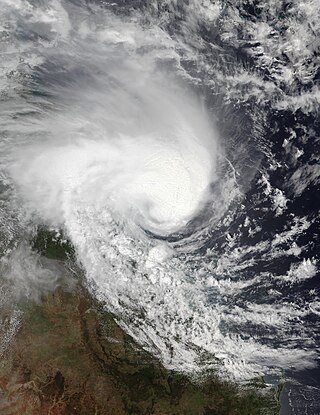
Severe Tropical Cyclone Kirrily was a long-lived and strong tropical cyclone that affected East Australia and the Northern Territory during January and February 2024. The third named storm and severe tropical cyclone of the 2023–24 Australian region cyclone season, Kirrily developed from a tropical low that formed within the Coral Sea. The system gradually developed, being in a favorable environment for further development with good outflow, low vertical wind shear, and warm sea surface temperatures, resulting in the system becoming a tropical cyclone intensity. The storm peaked on 25 January as a Category 3 severe tropical cyclone with sustained winds of 120 km/h (75 mph) and a minimum barometric pressure of 978 hPa (28.88 inHg). Kirrily made landfall northwest of Townsville, Australia. Kirrily weakened steadily as it tracked northwestward along the coast and was downgraded to a tropical low later that day. However, Kirrily remained traceable, as it moved westwards towards the Queensland region throughout the rest of January. The system only produced near-gale-force winds in the Gulf of Carpentaria, the Australian Bureau of Meteorology (BoM) determined that the low was not expected to redevelop into a tropical cyclone. Kirrily accelerated inland with the rainbands unraveling and warming cloud tops, until it was last noted on the BoM tropical cyclone outlooks on 3 February.
























